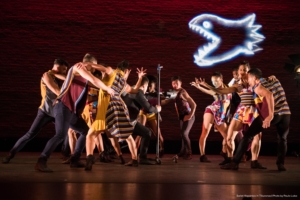Con Brazos Abiertos
DDP Visits Eduardo Vilaro and Ballet Hispánico
Eduardo Vilaro initially joined the Ballet Hispánico (BH) Company in 1988 and rejoined as Artistic Director in August 2009, becoming only the second person to head the company since its founding in 1970 (the founding director of BH was Tina Ramirez). In 2015, Mr. Vilaro added the role of Chief Executive Officer to his responsibilities. He has been part of the Ballet Hispánico family since 1988 as a dancer and educator until 1996. After completing his master’s in interdisciplinary arts at Columbia College Chicago, he embarked on his own act of advocacy, with a ten-year record of achievement as Founder and Artistic Director of Luna Negra Dance Theater in Chicago. Mr. Vilaro has infused Ballet Hispánico’s legacy with a bold and eclectic brand of contemporary dance that reflects America’s changing cultural landscape.
In early 2020, DDP Founder and President Liza Yntema brought her Listening Tour to Ballet Hispánico, her last stop before the COVID-19 lockdowns hit.

Joining her for a tour of the company’s facilities and meetings with leadership and staff was Isabelle Vail, DDP Director of Research. (A list of other Listening Tour stops may be found at the end of this feature). The purpose of the tour was to spend time with artistic and executive directors of American ballet companies and spend time promoting and discussing women and their interest in the ballet world.
During their visit to BH, Vilaro spent quite a bit of time discussing the importance of women’s roles in choreography and company leadership. Through each conversation, it became clear that Ramirez’s legacy as founder is ever present in Vilaro’s decision-making and vision for the company, which include his notable support of women at every level of the organization’s structure.
Vilaro rationalized his efforts to bank on women saying, “This field runs on the power of women,” women in positions of repetiteurs to choreographers to artistic leaders to administrators doing incredible work. “We need to allow their leadership.”

Discussions during the visit enlightened the DDP team about several new initiatives the company and school are pursuing to increase equity across the organization, especially when it comes to promoting the work of women. One such initiative is the recently-implemented Scholar’s Program, a new approach to mentoring talented young people in the community by addressing the “full range of issues they face as low-income youth who are motivated to reach their dreams.” Ten young people aged 5-7 will receive full dance training at BH through this program, with tuition and all expenses related to their dance training—shoes, dance specific clothing, and supplies—covered. In addition, the program will provide students and their families with wraparound services, like travel support, family guidance counseling, student tutoring, and nutrition support.
Describing the program, Vilaro added, “We feel that in order to create a platform for success, we must have a comprehensive, holistic, youth and family-driven way of supporting the students. Full scholarships and program support would be provided for 13 years, throughout the students’ K-12 education.”

The company has focused significant energies around promoting women choreographers. In 2019, the company presented its third iteration of a performance from entirely female choreographers. Vilaro expressed his feeling that BH’s commissions over the last few years have “opened up the conversation with and about female choreographers.” He believes women “are survival specialists, that their work feels more nuanced.”
Vilaro is continually focused on raising the profile of both female and Latino choreographers and influencing their position in the dance world through various initiatives, including the Instituto Coreográfico, a choreography institute for emerging Latino choreographers. The initiative aims to grow artists and allow audiences to respond, reflect, and enter into a cultural dialogue with the artists about dance and culture in a safe, critical environment.
Vilaro noted the road ahead is long and involves many stakeholders. He says, “It is not enough to bring women into the fold or to protect female dancers,” adding that the leadership must also come from the board level, which includes electing more women to board positions.
Vilaro’s visionary leadership and collaborative spirit have certainly validated Ballet Hispánico’s position as one of the most unique, inclusive, and relevant ballet institutions in North America today. Closing out his audience with DDP, Vilaro noted, “You cannot just see Swan Lake over and over. You need an opposing story.”

Image credit (from top to bottom images): Con Brazos Abiertos by Michelle Manzanales. Photo by PaulaLobo. Courtesy of Ballet Hispanico. | Naci by Andrea Miller. Photo by Paula Lobo. Courtesy of Ballet Hispanico. | Sombrerísimo by Annabelle Lopez Ochoa. Photo by Susan Bestul. Courtesy of Ballet Hispanico. | Tiburones by Annabelle Lopez Ochoa. Photo by Paula Lobo. Courtesy of Ballet Hispanico.
Learn more about the history of Ballet Hispanico here. Learn more about Eduardo Vilaro here.
Follow Ballet Hispanico on Facebook, Instagram, and Twitter.
Additional DDP Listening Tour Stops:
Alvin Ailey American Dance Theater | American Ballet Theatre | BalletX | Boston Ballet | Charlotte Ballet | Cincinnati Ballet | Dayton Ballet | Grand Rapids Ballet | Nashville Ballet | New York City Ballet | Pacific Northwest Ballet | Richmond Ballet | Smuin Ballet | The Washington Ballet




 Photo by Laurent Liotardo.
Photo by Laurent Liotardo.